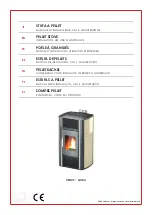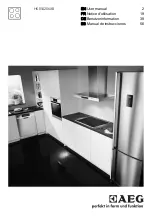
KOBE - FENICE - SPARK - INDACO - PRINCE - GO - ECLIPSE
26
6.19 DUCTING DATA
Fig. 73 - Ducting system example
• If the stove is not fitted with ducting system, it provide a hot air capacity ranging from a minimum of 44 m
3
/h to a maximum
of 86 m
3
/h with a temperature ranging between 95°C and 140°C.
• For the ducting system, we recommend using a pipe with a maximum length of 7 mt and up to three 90° elbows in order to
maintain hot air temperature.
• Use pipes with smooth internal surface and a diameter of 80 mm.
• Fit the pipe with insulating material if it passes through a cold wall.
• The outlet must be protected by a grid with wide mesh and a minimum total surface area of 40 cm
2
.
• If the pipes used are longer than 7 mt, the air capacity ranges from a minimum of 34 m
3
/h to a maximum of 70 m
3
/h and the
temperature from 50°C to 82°C. (These values refer to the laboratory used for the tests. The room where the stove is installed
may register different values both in terms of capacity and temperature).
• If you wish to increase air capacity, install at the end of the pipe a small wall-mounted fan with a capacity exceeding 130 m
3
/h.
The installation must be carried out by an authorised technician.
• According to the factory parameters, 1/2 of the generated heat is conveyed into the room where the stove is installed, while
the remaining 1/2 are conveyed through the left ducting pipe system.
• See the dedicated chapter of the USER MANUAL for the various adjustments.
6.20 ELECTRIC CONNECTION
Warning: the appliance must be installed by an authorized technician!
• The electric connection occurs through a cable with plug put in an electric socket which is able to support charge and tension
specific of every model, as described in the technical datas table (see
FEATURES a pag. 36
).
• The plug must be easily accessible when the appliance is installed.
• Please further assure you that your network is endowed with an efficient earth connection: if it does not exist or if it is not
efficient, please endow you with one in compliance with the law.
• Connect the supply cable first on the back of the stove (see
Fig. 74
and
Fig. 75
) and then at a wall electric socket.















































